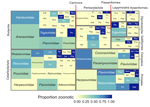Bats host the most virulent—but not the most dangerous—zoonotic viruses
Efforts to assess zoonotic risk often use trait-based analyses to identify which viral and reservoir host groups are most likely to source zoonoses, but have not fully addressed how and why the impacts of zoonotic viruses vary in terms of disease severity, capacity to spread within human populations, or total human mortality. We show that, while viruses transmitted by bats are more virulent to humans than average, viruses from close relatives (e.g., primates) are more transmissibile. Importantly, a disproportionately high human death burden is not associated with any animal reservoir, including bats.
More
Identifying and prioritizing potential human-infecting viruses from their genome sequences
We describe a machine learning model that identifies candidate zoonoses using evolutionary signals of host range encoded in viral genomes. This allows identification of high-risk viruses immediately upon discovery, increasing both the feasibility and likelihood of downstream virological and ecological characterization and allowing for evidence-driven virus surveillance.
More
Characterizing and evaluating the zoonotic potential of novel viruses discovered in vampire bats
A case study in evaluating the zoonotic potential of newly-discoved viruses using molecular sequencing data. We highlight the value of evaluating zoonotic potential beyond ad hoc consideration of phylogeny and provide surveillance recommendations for novel viruses in a wildlife host which has frequent contact with humans and domestic animals.
More
Viral zoonotic risk is homogenous among taxonomic orders of mammalian and avian reservoir hosts
Do some reservoir groups (e.g. bats) produce more zoonotic viruses than others? By cataloguing the accepted reservoirs for 415 viruses associated with mammals and birds, we show that there is currently no evidence for the existence of any such special reservoir groups. Instead, groups containing more reservoir species are associated with more viruses, and proportionally more zoonotic viruses.
More

